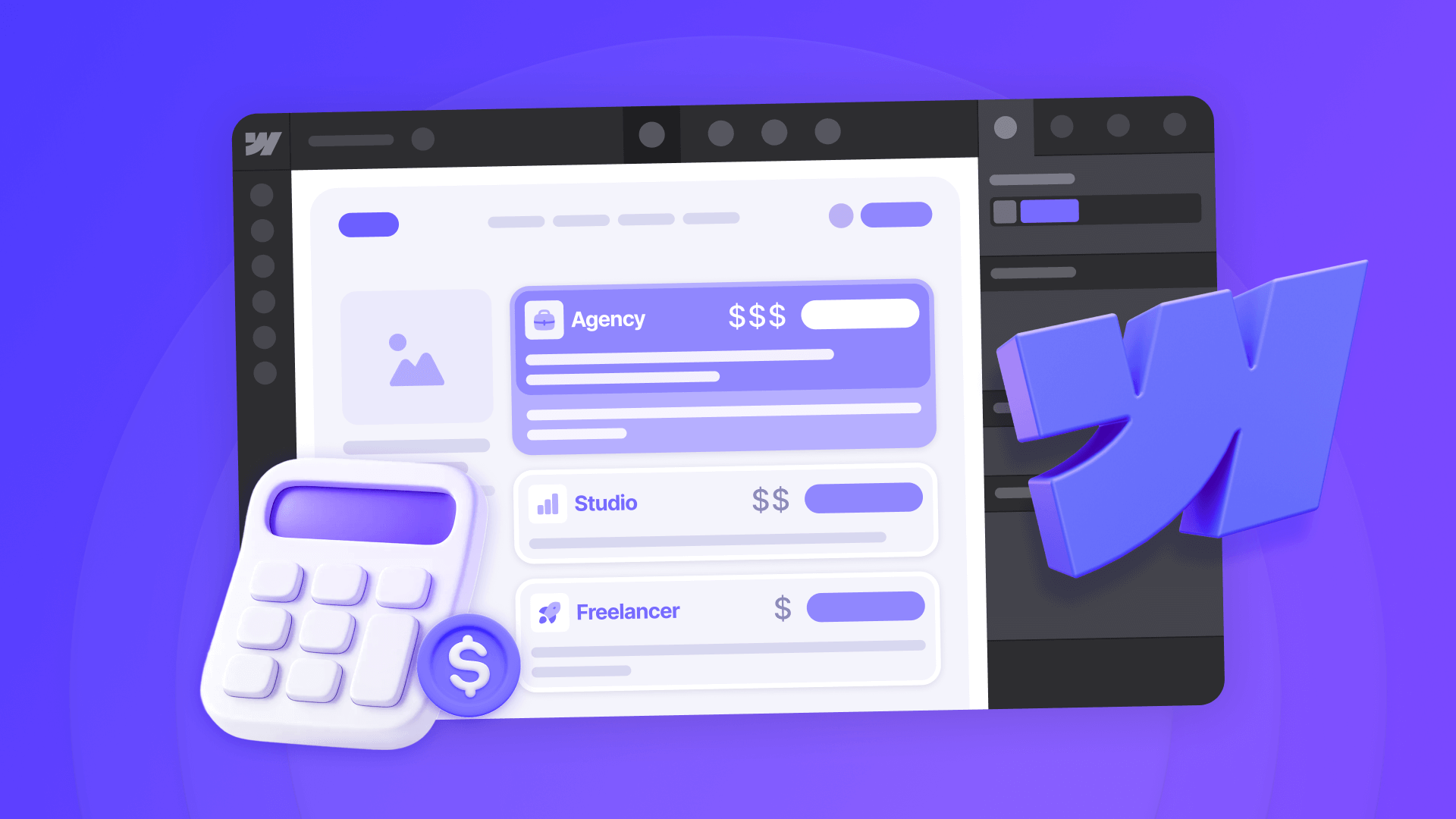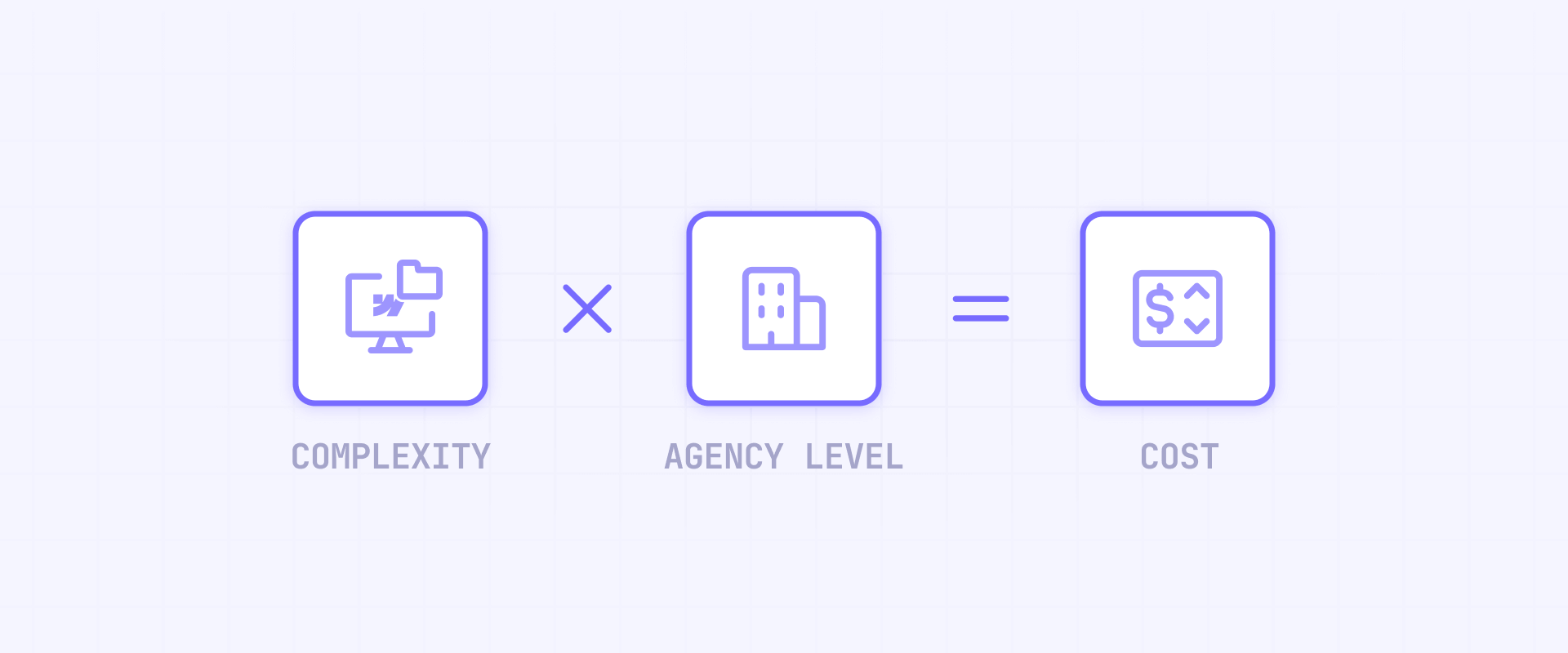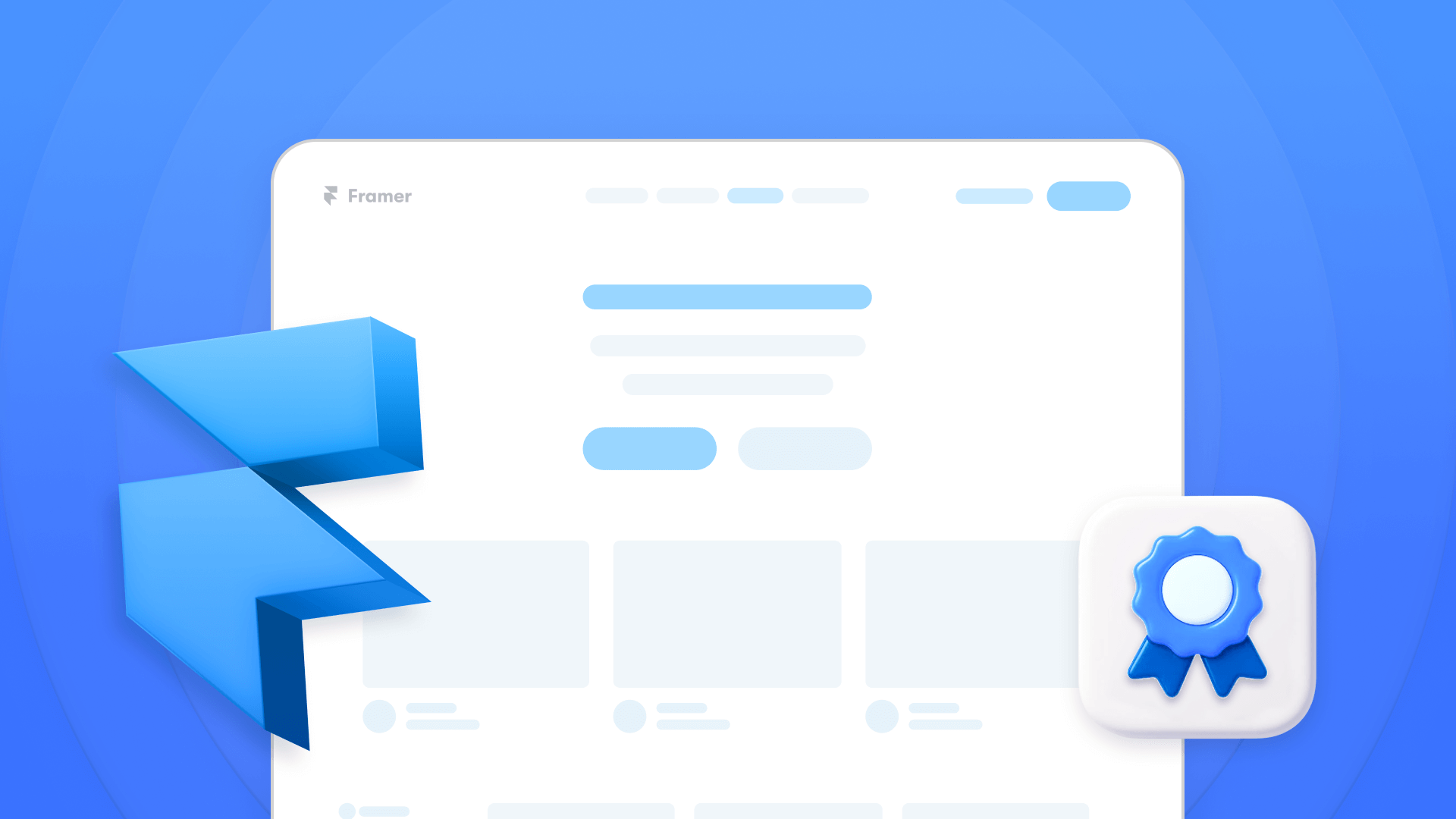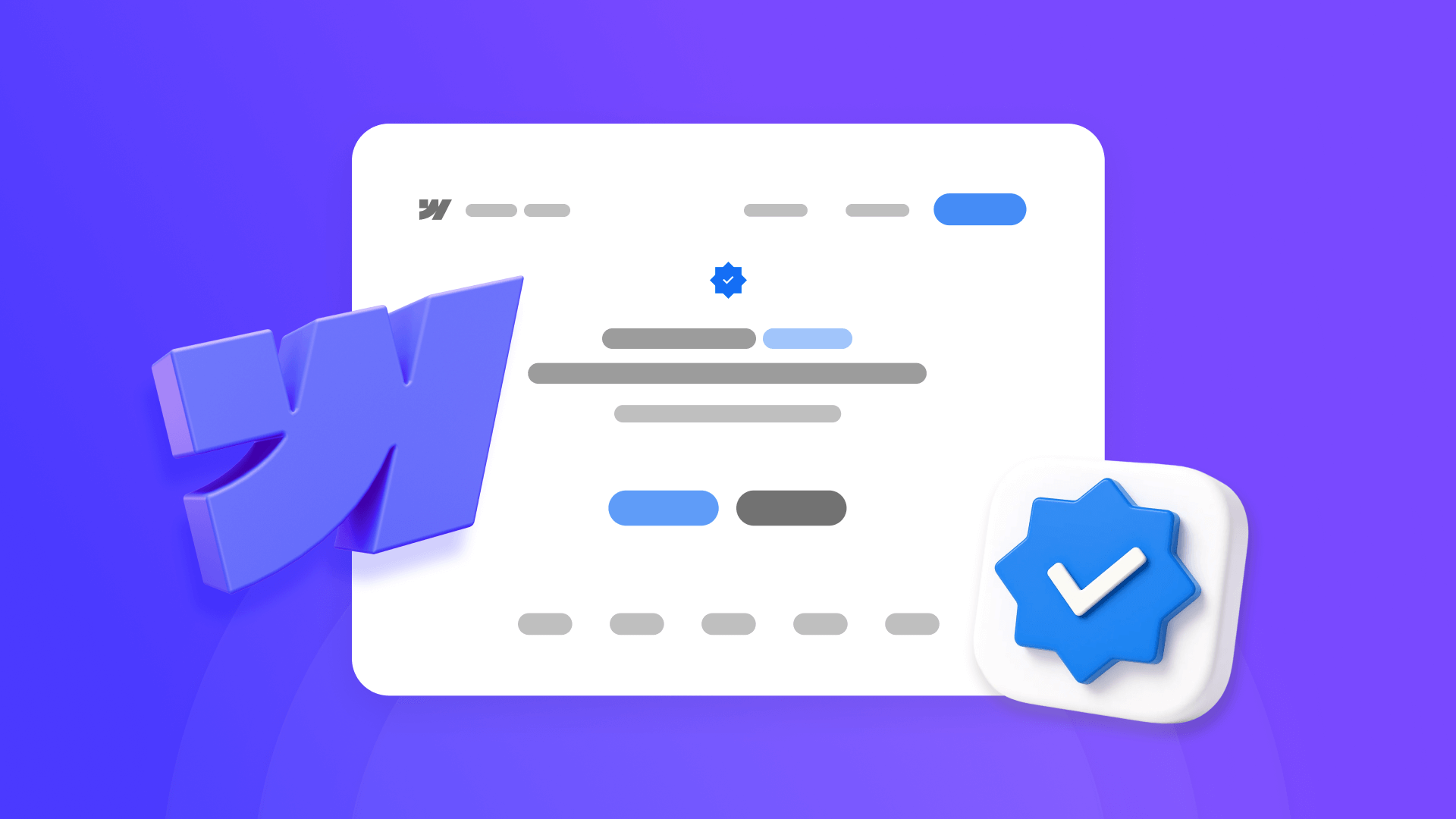

Webflow website pricing can be confusing when you're trying to budget for a project. A 10-page marketing site might get quoted at $8,000 from one provider and $35,000 from another, and both seem qualified.
The challenge isn't that agencies and freelancers hide their rates – it's that project complexity varies wildly and provider capabilities span an enormous range. What a solo freelancer considers a "simple marketing site" is completely different from what an enterprise agency with dedicated QA processes would scope for the same brief.
The reality is that Webflow website costs follow a predictable pattern once you understand the two factors that drive every quote: the complexity of your project and the agency quality level you choose. This guide breaks down real pricing data from dozens of agencies, freelancers, and retainer programs so you can budget accurately and compare quotes with confidence.
We'll walk you through the formula used to price projects, show you real pricing from subscription services and retainers, and give you a comparison checklist so you can evaluate quotes properly. You'll understand when a $3,000 quote makes sense and when a $50,000 investment is the right choice.

Why it's hard to find the right cost and Webflow provider for your project
The Webflow marketplace offers multiple pricing models across agencies and freelancers, each with different trade-offs that make direct comparisons difficult. Understanding which model fits your situation matters more than chasing the lowest headline price.
Here's what you'll encounter when shopping for Webflow services:
Hourly billing for Webflow work: You pay for actual time spent, typically $50-$200/hour depending on whether you hire a freelancer or an established agency. This gives flexibility but makes budgeting harder since final costs aren't known upfront. Works well for small tasks or unclear scope, but not recommended for full website projects where costs can spiral quickly
Fixed-price Webflow projects: Agencies and freelancers quote a total price for defined deliverables, giving you budget certainty but requiring precise scope documentation upfront. Great for new builds or redesigns with clear requirements, but scope changes trigger additional charges that add up quickly
Monthly Webflow retainers: You buy a set number of hours per month (like 20, 50, or 100 hours) at a discounted rate compared to hourly billing. This works well for ongoing maintenance and updates once your site is live, letting you spread costs predictably while building a working relationship with your provider
Unlimited Webflow subscriptions: Fixed monthly fee for "unlimited" requests, but work processes in a queue with typically one active request at a time. Popular for continuous updates at predictable costs, though "unlimited" really means "as much as we can deliver given our queue constraints and 24-48 hour turnarounds"
The surge in unlimited subscription services has made pricing comparisons even trickier because they're selling capacity and turnaround time rather than specific deliverables or hours. A $2,000/month subscription isn't directly comparable to a $20,000 fixed project or a 50-hour retainer without understanding throughput and queue mechanics.
Before comparing prices, figure out which model actually fits how you work: Do you have a one-time project with clear scope? Ongoing updates with variable volume? Continuous iteration needs? Your operational reality should drive the pricing model, not just what seems cheapest on paper.
The simple pricing formula for Webflow website costs

Webflow project costs boil down to a straightforward equation that explains 90% of the variance you'll see in quotes:
Estimated Cost = Project Complexity × Agency Level × $3,000
This formula works because complexity determines how much work is required, while the agency level determines the rate and process overhead applied to that work. Other factors like your location, project urgency, or a provider's reputation can push prices slightly higher or lower, but they're not the main drivers.
Understanding these two multipliers helps you check whether the quote you're getting is around the market rate for the quality level you need, or if you're being overcharged.
Understanding Webflow project complexity levels
Project complexity determines the base scope of work before you factor in who's executing it. Here's how to categorize your project:
- Small projects: 1-10 pages with light interactions and no complex integrations. Think landing pages, simple portfolios, or basic company sites with contact forms. These projects typically take 1-3 weeks for experienced teams
- Medium projects: 11-40 pages with CMS collections, moderate interactions, and light third-party integrations. Common examples include marketing sites with blog systems, service company sites with case study collections, or agency portfolios with filtering
- Large projects: 41-100 pages with complex CMS architecture, multiple integrations, heavy custom interactions, and design systems. These include SaaS marketing sites with extensive documentation, multi-product company sites, or platform landing pages with advanced filtering
- Enterprise projects: 101-200+ pages with multi-locale requirements, complex CMS architecture, compliance standards, custom API integrations, large-scale migrations with SEO parity, formal QA processes, and accessibility requirements. Think global company sites, regulated industry platforms, or extensive documentation systems
Defining Webflow agency quality levels and capabilities
Agency quality levels reflect process maturity, team size, and typical client profiles rather than just hourly rates. Here's how to match your needs to the right level:
- Top agencies: Award-winning teams with enterprise-grade processes, dedicated QA, formal strategy phases, and proven large-scale delivery. Teams like Refokus, BRIX Agency, and 8020 fall here. These agencies set project minimums – BRIX Agency starts at $10,000 while Refokus begins at $25,000+ – reflecting different operational structures but consistently high standards
- Mid-level agencies: 5-15 person studios with solid processes and clear offerings. They've done this enough times to have systems in place, often run monthly capacity programs or retainers, and work with companies that need reliable delivery without enterprise overhead
- Small or emerging studios: Newer agencies still forming their processes, often with tighter capacity and selective specialization. They offer more competitive pricing while building their portfolio and refining their systems
- Freelancers: Individual contractors with the lowest overhead and highest rate variance. Quality ranges dramatically, but experienced freelancers often deliver excellent work at accessible price points
Market-backed pricing ranges for Webflow projects

These ranges reflect real market rates based on transparent pricing from agencies, verified quotes from developer communities, and documented retainer programs. Use them as reality checks against quotes you receive.
The breakdowns below show typical project costs by combining complexity level with agency quality level:
Small Webflow projects (1-10 pages)
- Freelancers: $1,800-$4,500 based on repeated quotes in developer communities for basic builds
- Small studios: $3,600-$9,000 depending on design involvement and timeline
- Mid-level agencies: $7,200-$18,000 for professional delivery
- Top agencies: $12,600-$31,500 with established quality standards
Medium Webflow projects (11-40 pages with CMS)
- Freelancers: $4,500-$9,000 for straightforward implementations
- Small studios: $9,000-$18,000 with moderate interaction design
- Mid-level agencies: $18,000-$36,000 with proven processes
- Top agencies: $31,500-$63,000 with full process and quality assurance
Large Webflow projects (41-100 pages, heavy interactions)
- Freelancers: $9,000-$18,000 though many don't take projects this large
- Small studios: $18,000-$36,000 depending on integration complexity
- Mid-level agencies: $36,000-$72,000 with established delivery systems
- Top agencies: $63,000-$126,000 including strategy and custom development
Enterprise Webflow projects (101-200+ pages, multi-locale, complex CMS)
- Freelancers: Rarely equipped for enterprise requirements
- Small studios: $18,000-$51,000 for simpler enterprise needs
- Mid-level agencies: $72,000-$102,000 with specialized capabilities
- Top agencies: $126,000-$178,500+ for complex implementations with formal QA
These ranges account for typical scope within each category. Specific requirements – like extensive custom code, multiple integrations, or aggressive timelines – will push pricing toward the higher end or beyond.
A note on subscription services: Some agencies offer monthly subscription models where you can build projects across several months rather than paying a large upfront deposit. While this helps with cashflow, these services tend to be less predictable since they work with multiple clients simultaneously and process work in queues. You're getting incremental progress and small tasks rather than a dedicated team focused entirely on your project timeline.
Webflow subscription and retainer pricing models

Beyond one-time project fees, many agencies offer ongoing relationship models that change how you pay for Webflow work. The key difference comes down to how capacity is structured: traditional retainers give you a bucket of hours per month that you can use together or save for larger tasks, making costs highly predictable. Unlimited subscriptions process requests in a queue without defined hours, which works better for steady small updates but less well for concentrated work periods.
Understanding these differences helps you match the engagement model to your actual workflow needs.
Monthly retainers and unlimited subscription services for Webflow
These programs offer dedicated team capacity on a recurring monthly basis, letting you build and iterate continuously rather than in discrete projects. Here's what real agencies charge:
Flowout structures pricing around team composition with monthly programs:
- Developer only: $5,900/month for dedicated development capacity
- Developer + Designer: $7,900/month for full build capability
- Developer + Designer + Copywriter: $9,900/month for complete content and build
- Add-ons: Priority work costs an additional $1,900/month, while an extra developer adds $3,900/month
This model works well for medium projects delivered across 2-4 months, or ongoing small updates once your site is live.
Fitr Media offers unlimited request subscriptions at three tiers:
- Essential: $1,495/month with 24-48 hour turnaround
- Professional: $2,495/month with faster response
- Enterprise: $3,995/month with priority handling
The critical detail is that all tiers process one request at a time, meaning parallel work isn't possible and complex features take longer than the turnaround time suggests.
Other subscription options in the market include:
- Vestaso: Starting at $2,999/month for unlimited requests
- UnlimitedFlowDevelopment: Under $3,000/month with approximately 50 hours of work
- Designjoy: $5,995/month for design-first work with Webflow development available as a $999 add-on
The queue-based nature of these subscriptions means they excel at steady, small-to-medium updates but struggle with complex sequential features that require multiple rounds of review and refinement.
Traditional hourly retainers for Webflow maintenance
Retainer programs sell hours per month rather than unlimited requests, giving you clearer capacity planning and often more flexibility for complex work. Here are transparent examples:
BRIX Agency offers structured retainer tiers:
- 20 hours: $2,000/month for regular maintenance and updates
- 40 hours: $3,800/month for more substantial ongoing work
- 80 hours: $7,400/month for dedicated monthly capacity
Another example comes from Seattle New Media, which publishes hour blocks with volume discounts:
- 10 hours: $90/hour ($900/month) with 1-2 day turnaround
- 50 hours: $80/hour ($4,000/month) with same-day response on urgent items
- 100 hours: $75/hour ($7,500/month) with dedicated account management
The advantage of hourly retainers is predictability – you know exactly how much capacity you're buying and can plan complex work across multiple billing cycles without worrying about queue bottlenecks.
Don't forget Webflow platform costs in your budget

Agency fees are only part of your total investment. Webflow's platform subscriptions, workspace fees, and add-ons need their own budget line:
Webflow site plans (annual pricing):
- Basic: $14/month for simple sites without CMS
- CMS: $23/month for dynamic content (most common for marketing sites)
- Business: $39/month for advanced features like custom code export. Includes 100GB bandwidth per month – exceeding this would require paid add-ons that increase your monthly cost
- Ecommerce: $29-$212/month depending on sales volume
- Enterprise: Custom pricing for complex requirements
Webflow workspace and add-ons:
- Agency workspace: $35/seat/month (annual) for team collaboration
- Analyze: Starting at $9/month for analytics
- Optimize: $299/month for A/B testing and personalization
These costs apply whether you hire a $2,000 freelancer or a $100,000 enterprise agency. Factor them into your total budget from the beginning to avoid surprises after launch.
How to compare Webflow agency quotes effectively

When you receive multiple proposals, systematic comparison prevents choosing based on the wrong factors. Use this checklist to evaluate quotes on an apples-to-apples basis:
Scope documentation:
- Exact page count and unique templates required (a unique template is a custom page design, while templated pages are duplicates using the same template with just different text and images – for example, 20 blog posts would use 1 unique template, not 20)
- Number of CMS collections and estimated items per collection, including custom field requirements and relationships between collections
- Specific integrations needed with technical requirements – list every third-party tool (CRM, marketing automation, payment processors, analytics) and whether they need custom development or standard embeds
- Animation and interaction complexity level, specifying whether you need basic hover states, scroll animations, or complex custom interactions that require JavaScript
- Multi-language or multi-site requirements, including how many locales, content translation workflow, and whether you need separate staging environments
- Timeline and milestone structure with specific launch dates, review cycles, and any business constraints that affect scheduling
Team and process:
- Who specifically will work on your project and their role (designer, developer, project manager, strategist) plus their experience level
- Revision rounds included at each phase – typically 2-3 rounds for design, 1-2 for development, but get this explicit
- QA process and browser/device testing matrix specifying which browsers (Chrome, Safari, Firefox, Edge) and devices (desktop, tablet, mobile) are covered
- Meeting cadence (weekly, bi-weekly) and communication channels (Slack, email, project management tools) plus expected response times for questions
Deliverables and ownership:
- Transfer of Figma files, component libraries, and design systems with documentation for how to use them
- Class naming system documentation explaining the structure so your team can maintain consistency when adding new pages
- Training sessions for your team on how to use the Webflow Editor, update CMS content, and make basic design adjustments
- Post-launch support window – typically 30-90 days with specific coverage (bug fixes yes, new features no)
- Ownership of all code and design assets with confirmation that you can export and use everything without ongoing licensing fees
Post-launch terms:
- Retainer options with clear hour allocations
- Hourly rate for ad-hoc changes outside retainer
- Response time SLA for different request types
- Rollover policy if you don't use all hours
- Terms for contract changes or cancellation
References and capabilities:
- Case studies similar to your industry and scale
- Technical capabilities for your specific integrations
- Accessibility and performance optimization experience
- SEO migration experience with 301 redirects and ranking preservation if relevant to your project
This framework prevents comparing a $15,000 quote that includes strategy and training against a $15,000 quote that's just implementation hours. The deliverables and terms often matter more than the headline price.
For more detailed question templates to vet a Webflow agency, including red flags to watch for and how to assess technical capabilities, check out our complete agency evaluation guide.
Quick pricing calculator for Webflow projects
Below we've embedded a simple calculator that takes into account your project complexity and the agency quality level you're considering. Just select your options to get an instant estimate that aligns with real market rates.
Note: The calculator uses a more precise calculation system that adjusts pricing based on exact page count within each category, but the formula below gives you a reliable ballpark estimate.
The formula behind the calculator:
Complexity × Agency Level × $3,000 = Estimated Cost
Complexity multipliers:
- Small project (1-10 pages) = 1×
- Medium project (11-40 pages) = 2×
- Large project (41-100 pages) = 4×
- Enterprise project (101-200+ pages) = 8×
Agency level multipliers:
- Freelancer = 1×
- Small studio = 2×
- Mid-level agency = 4×
- Top agency = 7×
Examples:
- Medium project × Mid-level agency × $3,000 = 2 × 4 × $3,000 = $24,000 (matches our $15K-35K range)
- Large project × Top agency × $3,000 = 4 × 7 × $3,000 = $84,000 (matches our $55K-130K range)
- Enterprise project × Top agency × $3,000 = 8 × 7 × $3,000 = $168,000 (matches our $120K-200K+ range)
This calculator gives you a ballpark estimate. Your actual quote will vary based on specific requirements like custom integrations, animation complexity, and timeline constraints.
Frequently asked questions about Webflow website costs
How much does a Webflow website cost in 2025?
Webflow website costs range from $1,000 to $200,000+ depending on complexity and who builds it. Based on average pricing across multiple projects: solo freelancers charge $1,800-$18,000, small studios charge $3,600-$36,000, mid-level agencies charge $7,200-$102,000, and top agencies charge $12,600-$178,500+. A typical 11-40 page marketing site with CMS costs between $18,000 and $36,000 through a mid-level agency, while simple marketing sites can be built for $1,800-$4,500 by freelancers.
How much does it cost to hire a Webflow developer?
Hiring a Webflow developer costs $50-$200 per hour depending on experience and location. Freelancers on marketplaces charge $50-$90/hour, while established agencies charge $100-$200+/hour. For project-based work, freelancers quote $1,000-$20,000 depending on scope, small studios quote $3,000-$35,000, and agencies quote $7,000-$200,000+. Most developers prefer fixed-price projects over hourly billing since scope changes make hourly work risky for both parties.
What is the average cost of a Webflow website?
The average Webflow website costs $18,000-$36,000 for a medium-complexity project with 11-40 pages, CMS collections, and moderate interactions. This assumes working with a mid-level agency on a fixed-price project. Small 1-10 page sites average $7,200-$18,000, while large 41-100 page sites with complex features average $36,000-$72,000. Enterprise sites with 101-200+ pages, multi-locale support, and formal QA processes average $126,000-$178,500+.
Should I hire a Webflow agency or freelancer?
Hire a freelancer if you need a simple site (1-10 pages) with a $1,000-$10,000 budget and can manage the project yourself. Hire an agency if you need complex features, dedicated QA, formal processes, or have $15,000+ budgets where project failure would be costly. Freelancers offer lower overhead and faster decisions but higher variance in quality and availability. Agencies provide team backup, established processes, and accountability but charge 2-10× more due to overhead and formal project management.
How much do Webflow agencies charge per hour?
Webflow agencies charge $100-$200+ per hour depending on agency level and location. Small studios charge $75-$90/hour, mid-level agencies charge $100-$150/hour, and top agencies charge $150-$250+/hour when they quote hourly. However, most agencies avoid hourly pricing for full projects because scope uncertainty makes it risky. Instead, they prefer fixed-price projects or monthly retainers ($2,000-$7,500/month for 20-80 hours) for more predictable budgeting.
Is Webflow cheaper than WordPress development?
Webflow is typically cheaper both short-term and long-term than WordPress for similar projects. Short-term, Webflow sites build 30-50% faster due to visual development without complex plugin configuration and custom coding, which translates directly to lower development costs. Long-term, Webflow eliminates ongoing maintenance expenses that WordPress requires – no monthly costs for security updates, plugin licenses, compatibility fixes, or developer maintenance hours. Webflow includes hosting, security, SSL, and automatic updates in the platform subscription, while WordPress needs separate hosting, security monitoring, regular plugin updates, and frequent developer intervention to keep everything working together.
How much does a 10-page Webflow website cost?
A 10-page Webflow website costs $5,000-$35,000 depending on complexity and agency quality level. A freelancer charges $5,000-$10,000 for straightforward implementation with basic interactions. Small studios charge $8,000-$20,000 with more polish and design involvement. Mid-level agencies charge $15,000-$35,000 with proven processes and full QA. The price varies based on whether pages use unique templates (custom designs) or templated pages (duplicates with different content) – 10 unique templates cost more than 3 templates applied across 10 pages.
What's included in a Webflow retainer package?
Webflow retainer packages typically include 20-100 hours per month of maintenance work for $2,000-$7,500/month. Standard inclusions: content updates within existing pages, CMS item additions, minor design adjustments, form updates, performance optimization, bug fixes, and browser compatibility updates. Common exclusions that trigger extra charges: new page designs, major redesigns, complex custom code, new integrations, and brand design work. Quality retainers specify response time SLAs (1-2 day turnaround), QA coverage, and clear boundaries between included work and billable projects.
What are typical Webflow agency minimum project sizes?
Webflow agency minimums vary by quality level: freelancers typically accept projects starting at $1,000-$3,000, small studios have minimums around $3,000-$5,000, mid-level agencies often require $5,000-$10,000 minimums, and top agencies like BRIX Agency start at $10,000 while Refokus starts at $25,000+. These minimums reflect real operational costs including overhead for project management, QA processes, team coordination, and formal delivery systems. The higher minimums at top agencies aren't arbitrary gatekeeping – they reflect dedicated account management, formal strategy phases, and proven large-scale delivery capabilities that simply can't be delivered profitably below these thresholds.
How much does an unlimited Webflow subscription service cost?
Unlimited Webflow subscriptions cost $1,495-$9,900 per month depending on the provider and service level. Common pricing: basic plans at $1,495-$2,495/month, mid-tier at $2,999-$5,900/month, and premium at $7,900-$9,900/month. However, "unlimited" is misleading – these services process one request at a time with 24-48 hour turnarounds, making them slower than dedicated teams for complex work. They work well for steady small updates but struggle with parallel work or features requiring multiple revision rounds. Traditional retainers with defined hours often provide better throughput for complex projects.
How much does a large Webflow website cost?
A large Webflow website with 41-100 pages costs $36,000-$126,000 depending on complexity and agency quality level. Freelancers charge $9,000-$18,000 but rarely take projects this large. Small studios charge $18,000-$36,000 for moderate complexity. Mid-level agencies charge $36,000-$72,000 with established processes. Top agencies charge $63,000-$126,000 including strategy, custom development, and formal QA. Large sites typically involve complex CMS architecture, multiple integrations, heavy custom interactions, and design systems that require dedicated team coordination.
What factors affect Webflow project costs?
Webflow project costs are determined by two main factors: project complexity and agency quality level. Complexity factors include page count, unique templates needed, CMS architecture, animation complexity, third-party integrations, multi-language support, and migration requirements. Agency level factors include team size, process maturity, QA standards, and overhead costs. Based on average pricing: complexity multipliers range from 1× (simple) to 8× (enterprise), while agency level multipliers range from 1× (freelancer) to 7× (top agency). Additional factors like timeline urgency, brand reputation, and location can adjust final costs by 10-20% but aren't the main drivers.
Conclusion
Webflow website pricing follows a predictable pattern once you understand the two core variables: the complexity of your project and the agency quality level you choose. The complexity × agency level formula gives you a framework to evaluate any quote against real market data, while the calculator helps you estimate costs before reaching out to providers.
Use the pricing ranges in this guide to set realistic budgets, then choose between fixed projects for clear scope, retainers for ongoing work, or subscription models for continuous updates. Each model has trade-offs in predictability, speed, and flexibility that need to match your operational needs.
If you need help scoping your Webflow project or want pricing guidance tailored to your specific situation, our top-tier Webflow agency can give you an honest assessment of which approach makes sense for your goals and budget.

The best Framer agencies of 2025
Discover the top Framer agencies of 2025 with proven expertise in Framer design, development, and digital experience.

How to find the best Framer agencies for your project
Find vetted Framer agencies via expert directories, reviews, and showcases to compare platforms and make smart hiring decisions.

How to find the best Webflow agencies for your project
Discover vetted Webflow agencies through expert directories, review sites, and showcases to compare top platforms and hire confidently.












